When the ONAG Pro Team was told to head to Kedah for the next Angling Seminar, we were so excited. Preparations were made, lures were stocked, boats were loaded and outboards were serviced to ensure peak performance. Why the excitement you may ask?
Kedah is the land of paddy fields and where there are paddy fields there are irrigation canals and where there are irrigation canals there are the Snakeheads (Haruans). Coupled to this is the news that a couple of huge Giant Snakeheads (Tomans) were recently landed by the locals in Sungei Kedah that snakes through Alor Star not too long ago. Can this really be true? Can Sungei Kedah be clean enough to provide a habitat for the Toman despite its urban pressure?
During our briefing; Mejor Ismail said on Day 1, we would be plying upstream and downstream of Sungei Kedah from our base camp at the Hotel Royale, Alor Star. On Day 2, we would be targeting the irrigation canals of the paddy fields. This recce would be carried out by ONAG Pro Team members Mejor Ismail, Mohd Nor, Simon “Sameon” Lee, George “Johari” Chin and Richard Chuan. Our guest anglers would be Christopher “Baba” Chin, Chee Hoe and local angler Man.
 |
| Our battle mounts |
Arriving at our base cam on March 16, we got a first hand look at the the part of Sungei Kedah that runs beside the Hotel Royale. The colour of the water was not as we would have preferred it to be but we had hopes that it would deliver. On top of that, we found that there was not too much garbage or debris on the river surface which was a good sign. There were also numerous splashes by some fishes and once in a while, we could see the heads of water terrapins poking out of the water to breathe.
Day 1 started off after breakfast when we headed
down stream. As we went along the river, we could see that the house owners along the river were all proud of where there are situated. There were extensive renovations done to the backyards of most of the houses to make the riverbank part of their home. Some were innovative enough to incorporate a small jetty to accommodate a boat or two. Aside from the random discarded drink bottles and styrofoam boxes, the other flotsam were twigs, leaves and the occasional coconuts; a favourable indication.
There is still hope or so we thought but as we cruise further downriver, the telltale signs of human occupation leaped fourfold! Disposable diapers, plastic bottles and boxes, plastic bags, etc were everywhere. Despite a garbage boom put up by the authorities, it just could not cope with the quantity of rubbish thrown into the river! The Alam Flora workers were busy clearing the garbage as more kept coming!
 |
| Launching our boats |
Arriving next at a confluence of two rivers, we made a mental note to check it out later in the day as it posed many good ambush spots. Moving on, we noticed the number of houses reducing, indicating that we were now in more rural areas. We were enjoying the slow cruise until we came upon some unsightly object in front of us. Sitting just below the surface of the water were nets strung across the whole width of the river and many more after that one. A quick discussion among the team saw two boats deciding to go beyond the nets as I decided to return to the confluence we discovered earlier.
 |
| The perfect ambush spot - confluence of two rivers |
Reaching the confluence again, we chose a spot under a shady tree as we waited for the disturbance from our outboard to die down. Across the river were Nipah plants that provided good cover for predators and baitfish. Numerous fish splashes were evident everywhere with some very audible ones near the Nipah plants.
Casting out some subsurface lures towards the Nipah was met with disappointment. No splashes no pursuit, so we changed the lures to deep divers with the same results!
Going though the whole tackle box of lures produced the same disappointing results. How can this be? Why are there no takers to the lures when there are fish splashes in the water?
We decided to give it a rest and observe the fish activity instead. On closer observation, we noticed the splashes were made by a fish with dark hue and a crescent shaped tail! That can only the Plectostomas; the Ikan Bandaraya. An alien fish species brought into the country and have now colonized many bodies of water due to its high adaptability even in highly contaminated environment!
Not wanting to believe that there are no predatory fish in the river, we casted our arsenal again but to dismal results. It was now 1500hrs and with no fish to show for our efforts, we decided to call it a day. We met up with the other two teams and exchanged views on the poor fishing results. Mejor Ismail said it was too early to come to a conclusion until we have tried fishing upriver which we decided to do so after lunch.
 |
| Dead river bank due to herbicide poisons |
Simon’s team and Mohd Nor’s team decided to explore the upper reaches of Sungei Kedah while my team opted out of the expedition due to unforeseen circumstances. Around 1700hrs, Simon’s team came back to shore to report that there were many splashes but no fish taking the lures. What was more disappointing was the great number of empty herbicide bottles floating in the river near paddy fields.
Mohd Nor’s team came back around 1800hrs with the same dismal results. We called it a day and after a brief discussion, have come to the conclusion that Sungei Kedah’s fish population has dropped drastically due to the following factors:
a. netting
b. rubbish and other contaminants thrown into the river
c. poison through spraying of herbicide and run offs
d. loss of habitat with construction of homes near river banksIf Sungei Kedah is to return to its once pristine state where fish was in abundance, both the rakyat as well as the authorities must work together. Legislation governing the river system must be enacted and enforced.
a. There must not be any illegal netting as nets not only depletes the fishes but
hinder the migratory routes as well.
b. Garbage must be disposed in a civilized manner and not dumped into the river. The same goes for discharges from household and industrial drains and sewers.
c. Herbicide must be used in a controlled manner and its containers disposed in
properly managed locations.
d. There must be a set back for houses and other buildings situated near a river as its construction changes the course of the river from a soft environment to one of concrete; promoting the loss of water weeds and grasses on which fish eggs are laid and hatched.
e. There must be a continual education program for the public to love and take care of the river system. The public must be made to understand that it is a joint effort by the authorities and themselves.
f. Culling exercises on alien fish species followed by restocking of local species.
Legislation governing the importation of alien species must be tightened as most if not all of the alien species are brought in through the pet trade.
No doubt modernisation and development is important for the nation but we cannot justify such destruction in the name of development. If indeed development is necessary, we have to ensure that it is sustainable development where Nature is not compromised.
It is ONAG's hope that everyone; the authorities and the rakyat open their eyes to the downward spiral that Sungei Kedah is heading and put an immediate stop to its further destruction. Rehabilitation of Sungei Kedah should be made a priority for at the rate it is being compromised, it would be nothing more then a sewer in the next 5 years.
 |
| A sick river system that requires immediate rehabilitation |

Ikan Bandaran memang banyak di Alor Setar.. City fish for a City.. Aquarium owners dumped their Ikan Bandaran to Sungai Kedah once the fish becomes too big for their small/medium aquarium...
ReplyDeletePeople said that, Sungai Kedah got many big toman and kalui. These fishes inhibits further upstream and will be drawn down the river system as far as Bukit Pinang and Anak Bukit.. our prime spot for catching them since there are many Pokok Ara there..
Other than rainy season or the time when Pedu releases its water, those predators won't be around Alor Setar, most likely, I was told. So, lure fishing can be fruitless..
But, night fishing using 'anak Seluang hidup' often give good result near Mejor Ismail's house..
I think, we must do like Singapore.. all river banks were fenced in town/housing area.. Is it possible?
MR Ahmad H Al-Qadah'
ReplyDeleteActually, either realign or to concrete a river is a very big mistake. By concreting or realigning a river, we cause flash floods like whats happening in KL. When we straighten a river, the water runs faster and if the banks of the river has been concreted, there is no earth to soften the flow by absorption. Thus, flash floods occur. On top of that, when the river banks have been concreted, all the fish habitats would be destroyed so there is no place for the next generation of fish. Sad but our local authorities do not see this even though we have pointed it out to them.